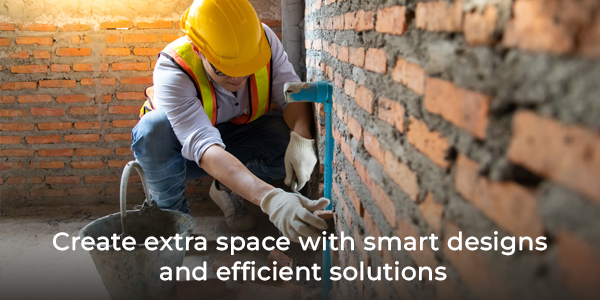Hi Buddy,
NoBroker Home Renovation Service
Get extra room construction, slab extension or one-wall construction. Competitive Pricing, End to End Execution

End to End Renovation Solutions for Your Home
6-Months Service Warranty
I was associated with a building construction company. It was during my work tenure, I learned why lime is used in cement? Over 2000 years have passed since lime was first used as a mortar binder. Today, lime is still frequently employed as the main binder in many mixes, typically in the form of hydraulic lime or lime putty. Modern cement-based mortars use hydrated lime primarily for its abilities as a plasticizer.
Consider NoBroker Home Interior services to have the finest materials used to create a high-quality interior. For the newest deals, visit this page.Hydrated and Cement High levels of flexural bond strength have been demonstrated with lime mortars. Cement-lime mortars have the following characteristics that increase high tensile bond strength.
Does cement have lime in it:
Calcium hydroxide or oxide is known as lime. To create calcium silicates and aluminates, lime must be present in adequate quantities. Lack of lime weakens the cement's ability to hold together. Lime deficiency causes the cement to firm up too quickly. The following table provides the general percentage of various components in cement:
| Ingredient | Percentage in cement |
Lime |
60-65 |
Alumina |
3-8 |
Silica |
17-25 |
Magnesia |
1-3 |
Iron oxide |
0.5-6 |
Sulfur Trioxide |
1-3 |
Calcium Sulfate |
0.1-0.5 |
Alkaline |
0-1 |
Why add lime to cement:
- Tensile Bond Strength:
This is the mortar's ability to hold the masonry units together under tension. The features of the mortar that result in high tensile bond strength are as follows;
Due to the significant water retention that lime offers, cementitious materials can cure as quickly as possible.
High initial flow makes it simple to cover all masonry pieces completely.
The cement-lime mortar's high binding strength is a result of its low air content.
- Extent of Bond:
The percentage of brick to which the mortar adheres is known as the extent of bond. The strength of the binding between mortar and brick is increased by the low air content, fineness, and stickiness of hydrated lime particles. Cement-lime mortars are able to seal the brick/mortar interface by penetrating the brick deeply due to these factors.
- Durability of Bond:
Numerous studies have shown that cement-lime mortars have a greater bond strength.
- Water leakage prevention:
Cement-lime mortars can be used, according to studies, to reduce the likelihood of water seeping into masonry walls.
For cement lime mortars, a low air content, fine particle size, high plasticity, and water retention all contribute to an optimum degree of bond. This removes water penetration pathways for simple migration.
- Autogenous Healing:
Hydrated lime reacts with atmospheric carbon dioxide when hairline cracks appear in the mortar. Limestone is produced as a result of this reaction, which aids in sealing the fracture and repairing mortar holes.
I would like to conclude here. I hope this answer suffices your query about why lime is used in cement.
Read More:
How To Check Cement Quality? What Is Cement Mortar?Your Feedback Matters! How was this Answer?
End to End Renovation Solutions for Your Home
✔
Dedicated Project Manager✔
6-Months Service Warranty✔
Cost Transparency
Build Extra Space
Get Free Quote

Avail Wall Construction
Get Free Quote

Get Slab Extension
Get Free Quote

Get Tiles Installed
Get Free Quote
Related Questions
Related Questions in Build Extra Space
Leave an answer
You must login or register to add a new answer .








Why Lime is Used in Cement?
Fatima
207 Views
1
2 Year
2022-07-06T16:48:11+00:00 2022-07-06T16:48:12+00:00Comment
Share